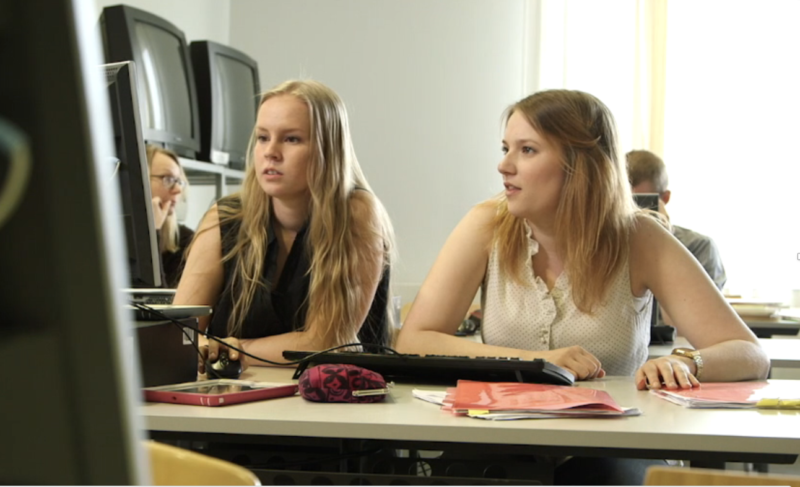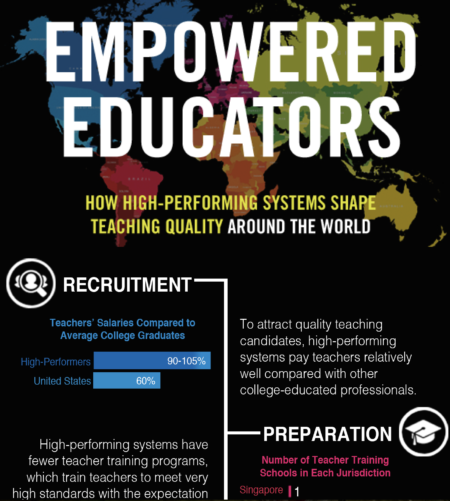 Teaching is one of the most sought after careers in Finland. About 90% of teachers remain in the profession for the duration of their careers.
Teaching is one of the most sought after careers in Finland. About 90% of teachers remain in the profession for the duration of their careers.
If there's one question from reporters that irritates Linda Darling Hammond, it is this: "So what's the one sure fix to improve our schools?" Darling-Hammond, a professor of education at Stanford University and president of the Learning Policy Institute, patiently explains that there is no "one thing."
"It's the system of things that come together to produce high quality," she says.
Darling-Hammond is a world-renowned expert on teacher quality and how high-performing systems recruit, train and retain a top-notch teacher workforce. Recently, Darling-Hammond and a team of researchers undertook a ground-breaking, comprehensive study that examines how seven systems across four continents have succeeded on this front.
“Across the jurisdictions we studied, we saw an intentional effort to build systems that produce not just high achievement, but also equitable outcomes,” said Darling- Hammond. “These systems ensure that all teachers are well prepared and supported throughout their careers, that all students have access to great teaching and leaders, that the students most in need of excellent teachers get them and that the schools that need the most funding and support to provide a high-quality education actually receive it.”
On June 6, education leaders and researchers gathered in Washington D.C. at a launch event for the new research, which was funded by the National Center on Education and the Economy (NCEE).
In his opening remarks, NCEE President Marc Tucker said the research makes a powerful case that the focus, if not obsession, in the United States on narrow "interventions" has been misguided.
The quality of the intervention isn't that relevant. It's the system that matters and top performing nations know this.
"These countries on their own undertook a revolution in how they thought about the teaching force," Tucker said.
The new study, Empowered Educators, looks at the strategies seven high-performing systems (New South Wales and Victoria in Australia, Alberta and Ontario in Canada, Finland, Shangai, and Singapore) designed and implemented to revamp teacher recruitment and preparation strategies, create new professional work environments, and elevate the status of the profession.
Each model is unique, but they share many similar approaches to reshaping and professionalizing teaching:
- Recruiting high-achieving students into their teacher education institutions is a priority.
- Teacher salaries are competitive with those in other professions. In Singapore, for example, teachers are paid on par with civil engineers and accountants.
- Most or all the costs of preparation are covered by the government, and some actually pay a stipend to candidates.
- Extensive induction and apprenticeship is available for new teachers.
- Professional development and support is is freely available throughout a teacher's career.
- Time is set aside during the work day for collaborative planning, action research, and peer coaching.
- Teachers are celebrated through public recognition and awards and public communication campaigns.
- Schools in general are well-funded and equitable, so that teaching is well-supported.
The average teacher attrition rate in these high-performing systems is 3 or 4%, significantly lower than the 8% rate in the United States. "If we could lower ours to 4%, we wouldn't have any teacher shortages," Darling-Hammond said.
In her presentation, Darling-Hammond also quickly dispensed with one of the most often-repeated misperceptions about many high-performing school systems: lack of diversity.
"You often hear, 'Well. these countries aren't like us, they're not diverse.' But it's not the case. Ontario has way more immigrants than New York does, and Australia also has a high immigrant and minority population."
"No one is exempt from issues around race and class." she added. "But these countries are not discriminatory in how they deal with their diversity the way the U.S. is."
 Infographic: How High-Performing Systems Shape Teaching Quality (Click to Enlarge)
Infographic: How High-Performing Systems Shape Teaching Quality (Click to Enlarge)
Karen Hammerness, director of Education Research and Evaluation at the American Museum of Natural History, who conducted the research into the Finnish system, said the debate over equity in Finland didn't occur when it overhauled its education system because it simply wasn't considered an issue up for debate.
"Finland has always had an emphasis on equity...that all students need access to education and to a highly-qualified, well-prepared teacher. This wasn't controversial, people didn't push back," Hammerness said.
Whether it's rigorous recruitment procedures, preparation and mentoring programs, or competitive salaries, the policies and practices deployed in high-performing systems are emblematic of a commitment to making teaching a highly-respected profession.
"Strong teachers means strong education," said A. Lin Goodwin of Columbia University who examined Singapore's system. "And teachers need to stay in the system so that the system benefits from their wisdom."
One of the standout components in Singapore's system are the professional opportunities - "career ladders" - made available to educators for advancement and leadership. There are three primary routes for career advancement: the teaching track, the leadership track, and the senior specialist track.
Singapore's attrition rate is less than 3%, a remarkably low number by international standards.
The deprofessionalization of teaching in the United States, on the other hand, has reached a crisis stage, said National Education Association President Lily Eskelsen García. A recent large-scale NEA survey of educators in their first five years revealed some discouraging results.
"When we asked them whether or not they would continue as teachers, overwhelmingly they thought they made a mistake," Eskelsen Garcia recalled. "That was so unexpected. But they said they didn't feel empowered, that they had to scream and push just to get their voices heard."
Eskelsen Garcia pointed out, however, that all the best resources and a highly-trained, well-prepared teacher workforce can only accomplish so much if, at the end of the day, the narrow, scripted curriculum isn't also rooted out of the system.
"The system has to give these incredibly well-prepared talented professionals collaborative authority to design something that makes sense for the students in their care," Eskelsen García added.
As Darling-Hammond noted, there are "pockets of excellence" scattered across the United States, as a few states - namely Connecticut and Massachusetts - have built up the teaching profession over time and have the student achievement to show for their efforts.
"States have taken this up," Darling-Hammond said. "If we can keep politics out of it, we would be in a position to experience and reap the benefits of the good work that has already been sown."







